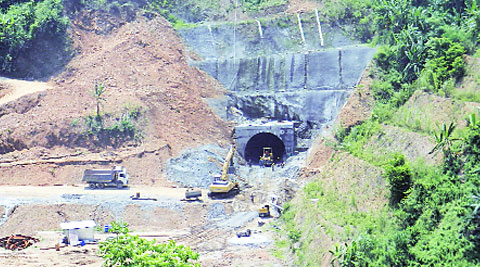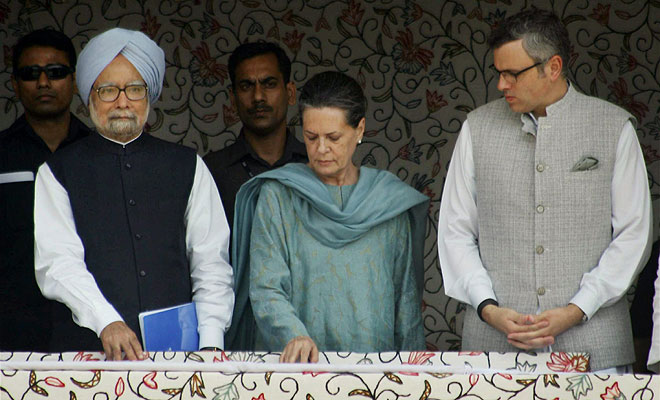Imphal, Aug 6 : India and Myanmar have decided to shape up the proposed joint-venture thermal power project in Myanmar's Sagaing region, boosting the bilateral ties of the two neighboring countries.
A joint meeting to this effect was held on Monday in the office of Tamu township military headquarters in Myanmar, about 5 Km from Manipur's border town Moreh, a source said.
The gateway to southeast Asia and a focal point of India's ambitious 'Look East Policy', Moreh has witnessed rapid progress of the economic development projects since the past few years. If the power project is successfully implemented, India would provide financial assistance and the required equipment for it, while Myanmar would offer the required land, the source added.
Manipur commerce and industry minister Govindas Konthoujam and Indian consulate general in Mandalay, N Nandakumar represented India, while union minister U Khin Maung Soe of the ministry of electric power, Sagaing region, led the Myanmar delegation at the meeting.
U Khin Maung, who was enthusiastic in setting up the power project, said he would discuss the matter with his country's top leaders and inform the same to India. Minister Govindas urged the Myanmarese delegates to extend support to the construction of the proposed Integrated Check Post (ICP) at Moreh aimed at boosting the ongoing commercial activities in Myanmar. On Govindas' appeal to release six Manipuris, who were apprehended by Myanmar Army, the neighboring country's delegates dropped positive hints, stating that the issue of releasing the captives would be considered.
Power officials, trade and chamber of commerce unit leaders both the countries attended the meeting. Chief minister Okram Ibobi Singh, who addressed the meeting titled "Region Investment and Business Conclave" in the Sagaing region in May this year, had called upon Indian investors not to think for India alone but also Myanmar so that the two countries could co-exist.
Ibobi Singh suggested that investment in the Sagaing region is very much possible in power sector by generating power in the thermal power plants, agro-industries. He suggested setting up of educational institutions and hospitals during the conclave attended by hordes of Indian businessmen.
A joint meeting to this effect was held on Monday in the office of Tamu township military headquarters in Myanmar, about 5 Km from Manipur's border town Moreh, a source said.
The gateway to southeast Asia and a focal point of India's ambitious 'Look East Policy', Moreh has witnessed rapid progress of the economic development projects since the past few years. If the power project is successfully implemented, India would provide financial assistance and the required equipment for it, while Myanmar would offer the required land, the source added.
Manipur commerce and industry minister Govindas Konthoujam and Indian consulate general in Mandalay, N Nandakumar represented India, while union minister U Khin Maung Soe of the ministry of electric power, Sagaing region, led the Myanmar delegation at the meeting.
U Khin Maung, who was enthusiastic in setting up the power project, said he would discuss the matter with his country's top leaders and inform the same to India. Minister Govindas urged the Myanmarese delegates to extend support to the construction of the proposed Integrated Check Post (ICP) at Moreh aimed at boosting the ongoing commercial activities in Myanmar. On Govindas' appeal to release six Manipuris, who were apprehended by Myanmar Army, the neighboring country's delegates dropped positive hints, stating that the issue of releasing the captives would be considered.
Power officials, trade and chamber of commerce unit leaders both the countries attended the meeting. Chief minister Okram Ibobi Singh, who addressed the meeting titled "Region Investment and Business Conclave" in the Sagaing region in May this year, had called upon Indian investors not to think for India alone but also Myanmar so that the two countries could co-exist.
Ibobi Singh suggested that investment in the Sagaing region is very much possible in power sector by generating power in the thermal power plants, agro-industries. He suggested setting up of educational institutions and hospitals during the conclave attended by hordes of Indian businessmen.












 Hunting of frogs is a serious threat to the ecosystem. Feeding on pests, frogs are natural pest controller.
Hunting of frogs is a serious threat to the ecosystem. Feeding on pests, frogs are natural pest controller. 








 Sanamahhi
Motors proprietor W Kumar; Sales and Service Eastern Region manager for
Royal Enfield, RK Sachdeva; All Manipur Working Journalists’ Union
president Wangkhemcha Shyamjai, M Chitaranjan, G Prafullo and otheres
were in attendance.
Sanamahhi
Motors proprietor W Kumar; Sales and Service Eastern Region manager for
Royal Enfield, RK Sachdeva; All Manipur Working Journalists’ Union
president Wangkhemcha Shyamjai, M Chitaranjan, G Prafullo and otheres
were in attendance.  Past
few years has seen the number of Royal Enfield riders in the state
grow. Royal Enfield has 307 dealerships pan India and is focusing on
North East, especially Manipur and Assam. Royal Riders Manipur has been
instrumental in getting riders together and organising activities here.
6th edition of North East Riders’ Meet (NERM) is scheduled for
5-7-Nov-2014 at South Loushing near Chingnungkhok, Lamlai, Imphal.
Past
few years has seen the number of Royal Enfield riders in the state
grow. Royal Enfield has 307 dealerships pan India and is focusing on
North East, especially Manipur and Assam. Royal Riders Manipur has been
instrumental in getting riders together and organising activities here.
6th edition of North East Riders’ Meet (NERM) is scheduled for
5-7-Nov-2014 at South Loushing near Chingnungkhok, Lamlai, Imphal. After
a long detour around Bangladesh, the riders reached Nagaland and
Manipur having first crossed Patna. The North eastern regions that feel
very different to the rest of India entailed a border crossing at
Nagaland guarded by heavy military presence, and foreigners have only
recently started entering these areas. The 10 armed women guards at the
border welcomed the riders.
After
a long detour around Bangladesh, the riders reached Nagaland and
Manipur having first crossed Patna. The North eastern regions that feel
very different to the rest of India entailed a border crossing at
Nagaland guarded by heavy military presence, and foreigners have only
recently started entering these areas. The 10 armed women guards at the
border welcomed the riders. With
breakdowns to be dealt with and no Enfield dealer in Imphal at the
time, the Aussies planned to contact Eddie, a member of the Royal
Enfield club, Royal Riders, but with no mobile network coverage, that
wasn’t to be. This is when Eddie pulled up on his Royal Enfield having
been riding around 2 states looking for them so he could ride with them.
The group left from Imphal after meeting more ‘Royal Riders’ before
heading to the Myanmar border.
With
breakdowns to be dealt with and no Enfield dealer in Imphal at the
time, the Aussies planned to contact Eddie, a member of the Royal
Enfield club, Royal Riders, but with no mobile network coverage, that
wasn’t to be. This is when Eddie pulled up on his Royal Enfield having
been riding around 2 states looking for them so he could ride with them.
The group left from Imphal after meeting more ‘Royal Riders’ before
heading to the Myanmar border.





